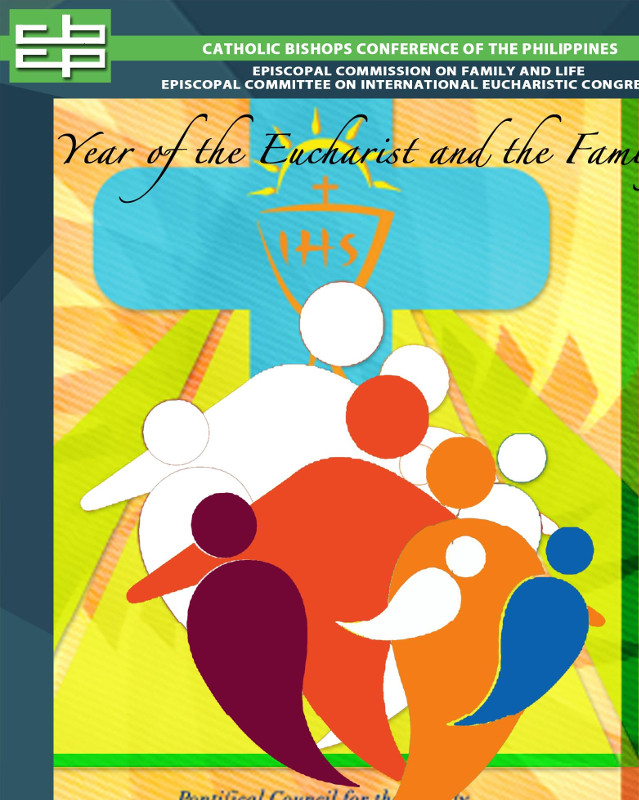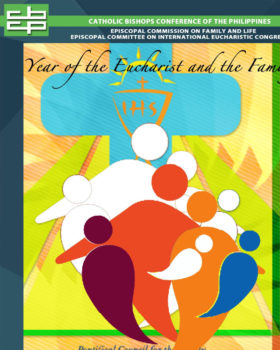
Logo Explanation of the 2016 CBCP “Year of the Eucharist and the Family”
 On 2021, we will celebrate the 500th anniversary of the first Eucharist and first Baptism in the Philippines. To prepare for this milestone and beyond, we started an “Era of New Evangelization” in 2012. After years devoted to integral faith formation, the laity and the poor, 2016 will be the Year of the 51st International Eucharist Congress and Year of the Family. It will also be the Extraordinary Jubilee of Mercy and the year when we start to implement Pope Francis’ Encyclical Laudato si’ on Care for Our Common Home. Since “the future of humanity passes by way of the family” (St. John Paul II, Familiaris Consortio, n. 86), the theme chosen for 2016 is “The Filipino Family: Missionary Disciples of the Eucharist”.
On 2021, we will celebrate the 500th anniversary of the first Eucharist and first Baptism in the Philippines. To prepare for this milestone and beyond, we started an “Era of New Evangelization” in 2012. After years devoted to integral faith formation, the laity and the poor, 2016 will be the Year of the 51st International Eucharist Congress and Year of the Family. It will also be the Extraordinary Jubilee of Mercy and the year when we start to implement Pope Francis’ Encyclical Laudato si’ on Care for Our Common Home. Since “the future of humanity passes by way of the family” (St. John Paul II, Familiaris Consortio, n. 86), the theme chosen for 2016 is “The Filipino Family: Missionary Disciples of the Eucharist”.
The green frame symbolizes the world in which we live. The waves in the background recall the countless generations and diverse cultures of the human family, all of whom are called to “an integral ecology lived out joyfully and authentically” (Laudato si’, n. 1). Green is the color of life. In and from the family we nurture and promote life and love. With every new life, the springtime of hope emerges.
The people symbolize the family as designed by God to reflect his own creative love: a man and a woman united by love, open to becoming father and mother to the children that God would grant them. This is the foundation of human society and civilization: the natural experience of belonging to a loving family in which we learn faithfulness in the midst of betrayal, forgiveness in response to conversion, courage born out of hope.
That the members of the family are five also represents the Filipino way of responding to being Catholic: family-oriented, meal-oriented, kundiman-oriented, bayani-oriented, spirit-oriented (Catechism for Filipino Catholics, nn. 34-44).
Specifically, “The anak-magulang relationship is of primary importance to us Filipinos. Ama, ina, and anak are culturally and emotionally significant to us Filipinos who cherish our filial attachment not only to our immediate family, but also to our extended family (ninongs, ninangs, etc.). This family-centeredness supplies a basic sense of belonging, stability and security. It is from our families that we Filipinos naturally draw our sense of self-identity. Jesus as both the Son of God (Anak ng Amang Diyos) and the Son of Man (Anak ng Tao) endears himself naturally to us family-oriented Filipinos. As Son of Man, Jesus leads us to his Mother Mary (Ina ng Diyos) whom he shares with us (cf. Jn19:26-27). He thus welcomes us into his own household, offers himself as our brother (kapatid), and draws us through the Sacrament of Baptism to a new identity and into the family life of his heavenly Father (cf. Jn 3:5-7).What can better remind us Filipinos of our early childhood, or respond more directly to our traditional love for children, than Jesus, the Sto. Niño? At twelve, Jesus was a discerning and daring child, who nonetheless remained obedient to his parents (cf. Lk 2:41-51). In his public life, Jesus embraced little children and admonished his disciples to become child-like in openness and simplicity (cf. Mt 18:2-4). In our family-orientedness, then, we Filipinos are naturally attracted to Jesus of Nazareth, Son of God and Son of Man. Thus, PCP II 46-48 stress the exceptional importance of our Filipino family as both subject and object of evangelization” (CFC nn. 34-36).
The cross represents Jesus who grants us salvation through his redemptive suffering, death and resurrection. Jesus incorporates us into his Body through baptism by water and the Spirit. Blue is the color of the innermost and hottest part of the flame. This is Jesus, who is at the center, and inner-most core of the human family from whom life and all virtues come, the Spirit from which the family becomes the missionary disciples of the Eucharist. The radiant host and golden chalice with IHS symbolizes the Eucharist as the sacrament in which “Christ is received, the memory of his Passion is renewed, the mind is filled with grace, and a pledge of future glory to us is given” (O Sacrum Convivium).
Jesus’ Paschal Mystery is especially mirrored by family virtues and values:
- red father: sacrifice, dedication, willingness to die for the family (Priest, provider and protector)
- orange mother: endurance and strength, passion tempered by wisdom: the feminine genius (St. John Paul II, Mulieris Dignitatem, n. 30.)
- brown child: humility, docility, industriousness, perseverance, patience
- blue child: Marian (CFC 45-47), prayer, piety and service to God’s people
- white baby: purity, innocence, baptismal grace, springtime of hope
The three rays that emanate from the Cross and Eucharist refer to the three-fold kneeling required by renewal: repentance and mercy, adoration and prayer, love and service. We also recall the three words that Pope Francis wants every family member, especially spouses, to say everyday to each other: “please”, “thanks”, “sorry” (Address to participants in the pilgrimage of families in the Year of Faith, 26 October 2013).
To live the Gospel of mercy, to proclaim and become witnesses of God’s love, the great gift of family and life, and to care for our common home, is every family’s call to be missionary disciples of the Eucharist.


No Comments